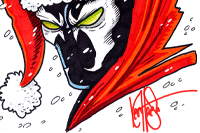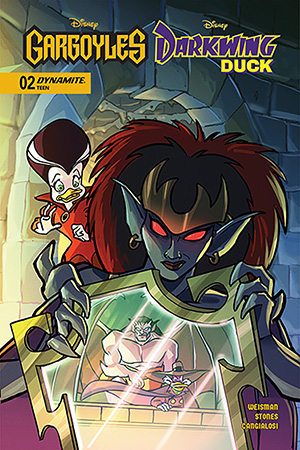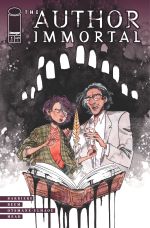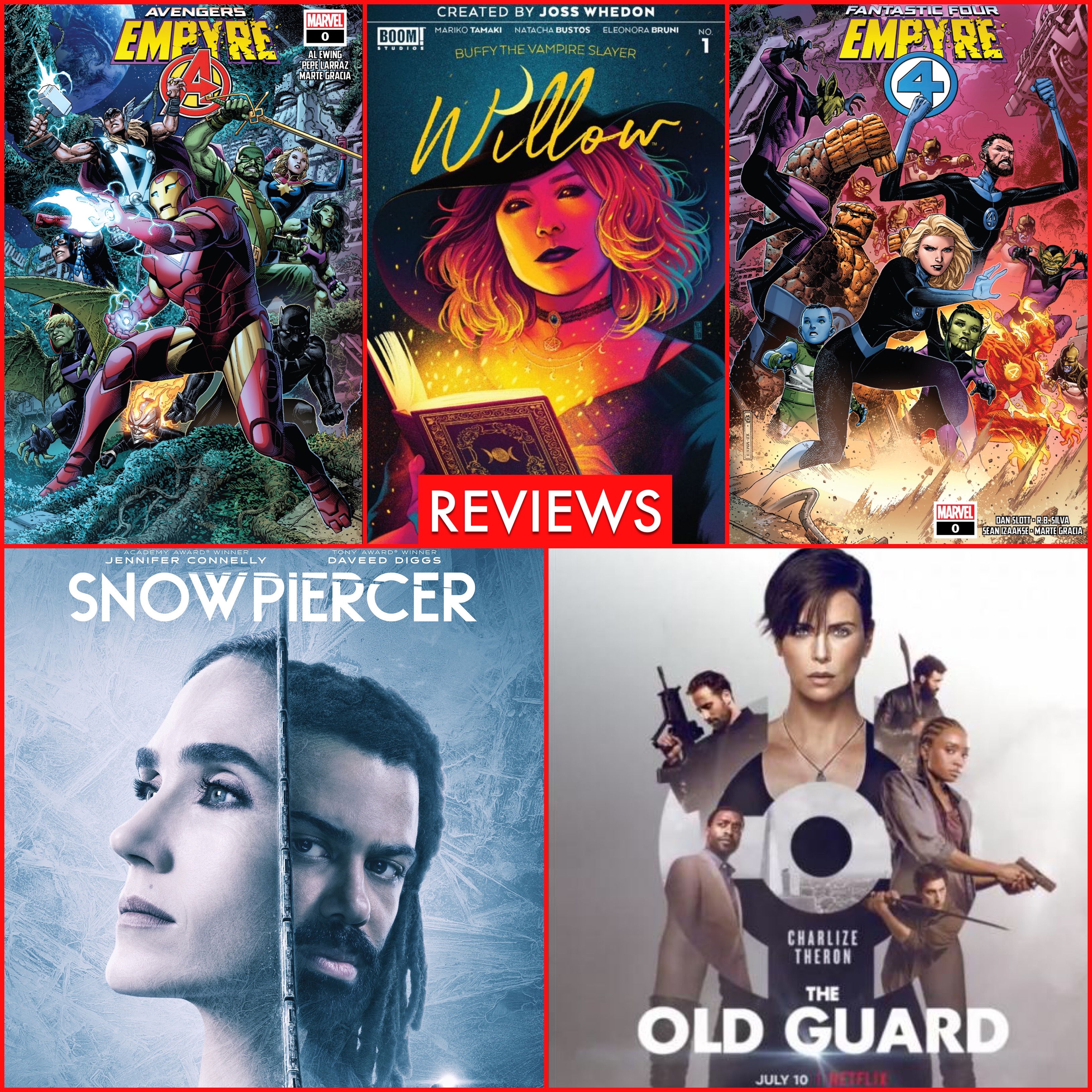Waiting For Tommy XXXVII
By Richard
Johnston |
Joe
Q and Bill
J were all in favour of us forgetting the rules that
would apply to a MU project which left us free to examine
everything with a fresh attitude. Starting from scratch
also meant introducing all of our cast to people who hadn't
seen an Avengers comic before. That meant more character
work. If you are presenting some pretty far out and unbelievable
stuff you have to have characters with believable reactions
that persuade you to believe in what's happening otherwise
readers are unwilling to suspend their disbelief. We had
to assume no previous experience or familiarity with Avengers
and go from the ground floor up, which is why I have to
completely disagree with your assertion that we have corrupted
these characters. How can we have? Those characters are
alive and well in The Avengers and doing just what they
always have done in their own book. This is not that book
and these are not those characters. They were never intended
to be and never will be, for good or bad they are The
Ultimates, NOT the Avengers. They will follow their own
paths. They are separate and they are certainly different.
Avengers is a classic Superhero cartoon adventure, Ultimates
is a war comic. The interesting thing about our book
isn't always the action, of which there has been relatively
little, but the human side of people who do superhuman
things. One reviewer recently made mention that even
though the bitch slapping Rogers gave Pym in issue #9
was satisfying, far more interesting was the preparation
for battle in the second half of the issue. This to
me is one of the biggest differences between us and
The Avengers: the focus isn't how big the threat is
or the action involved in defeating it, (that stuff
we still have of course) but in the Avengers comics,
they have been doing the job for thirty odd years and
our guys are new to it and finding their feet. The sense
of wonder and the sense of danger are still there. This
being the Ultimate Universe we can do things we couldn't
do in the regular Marvel universe. Any of our characters
can die, get arrested, go bad; they can change and stay
changed.
Well, that and we outsell them more than 2-1 of course.
We are actually at an advantage over the Marvel Universe
Avengers in that our characters do not have their own
titles, therefore their continuity and development is
not dictated by other creative teams on individual comics.
That gives us far more latitude for development than
would normally be the case on a book like JLA
and Avengers, probably also why [George]
Perez and [Marv]
Wolfman's Titans and The X-Men
were their companies biggest sellers in their day. If
you think about it, this is probably why writers on
these sorts of team books normally create new characters
or shift the focus from the guys with their own books
to the second stringers. I found this during my brief
tenure on JLA. [Grant]
Morrison had, I think, the right approach to that
sort of book by jettisoning any attempt to explore the
characters individual continuity beyond the JLA, he's
simply got on with telling big stories liberated from
the need for too much back story on each member. [Mark]
Waid wanted to more explore the characters and their
motivations, which is of course an excellent and valid
approach but one we didn't realise would hamstring us
so much. Nothing we could do would have any lasting
impact on their characters because of their own titles
and creators. There is absolutely no way we could do
on Avengers what we are doing on the Ultimates, even
if we took over the Avengers tomorrow we couldn't make
these books the same for the above reasons if nothing
else, but mainly because they really are different books,
and despite the names, different characters.
I think it's perfectly possible to enjoy both books
on their individual merits without the need to say one
is a violation of the other.
RICHARD:
Kurt
Busiek quit the Avengers because he didn't want
to compete against you guys... a victory for The Ultimates
team?
BRYAN:
Only if you see it as a competition, which we don't.
The Mighty Morphin' Millar and I are only really interested
in challenging each other and we work very hard on what
we do. We certainly don't set out to be better than
other people's projects and works, only to better our
own.
Anyway, I don't believe that statement about Busiek
at all. It would seem more likely that he left because
the synergy was between him and Perez and without George
it was only half a process. That was the real reason
I wasn't interested in doing Authority without Warren
[Ellis], no matter how good Mark is. It's also why
I won't do Ultimates without him either.
Anyhoo, I say all this guff by way of answering your
contentious questions, but our way of making comics
doesn't really need defending. Our approach is clearly
successful, clearly saleable and clearly appreciated
in the majority, which is just groovy. This could all
change I daresay, but as long as we try to tell good
stories with honesty and conviction done to the best
of our abilities I believe we will find an audience.
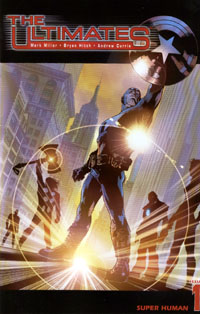
THE
ULTIMATES #1 - SIGNED VERSION |
RICHARD:
Yeah, talking about your storytelling skills,
what's all this widescreen nonsense, eh? It's
just padding isn't it? Stretching a one issue
story into four or five, when Stan Lee could probably
have fit it into eight pages. Oh, all very pretty
I'm sure, but with the increasing cost of comics,
aren't you lot just giving less bang for buck?
Why, in my day, a superhero team could save the
world twice before the first Hostess cake ad,
etc etc...
BRYAN:
And there will no doubt be people who grow up
reading comics done this way and find the more
compressed approach quaint and old fashioned.
It really isn't padding and I think you are confusing
two separate things here. |
To
my mind the widescreen approach is more to do with the
way I layout a panel and the composition within it;
how one uses the space within a frame, if you like.
With Ultimates I try to keep all the panels horizontal,
emulating a movie screen or TV screen. I have been proceeding
from the idea that in attracting new readers we must
assume that they have no understanding of the conventions
of comic book layout and storytelling. Let's face it
a number of comics have almost incomprehensible layouts.
Angular panels, people leaping from the frames and overlapping
other panels and sometimes almost no storytelling. Certainly
no sense of environment. All of these things have become
acceptable to established (hardcore, if you like) readers,
but if you can step outside of that comic fan mindset
and look at objectively at what we accept as the norm
you can't help but see how odd it all is. Every other
visual storytelling form such as TV and cinema are presented
in rectangles or squares. If this is all you are familiar
with the preoccupation in comics of avoiding clear storytelling
could well be confusing. Mostly it results in poor examples
of the form. We must always remember that first and
foremost this is a visual storytelling medium and that
all the artwork must exist to serve and further the
story and should be done in the most clear, simple and
effective way possible.
There is so much to convey in each issue: Character
acting, fluid and dramatic action, mood, atmosphere,
set design, lighting, and emotion. All of these are
used in accordance with the story one is telling and
dictate the pace and rhythm of the storytelling.
The stretching, or padding of a story you refer to isn't
widescreen at all, it's decompression. This is something
that has existed in Japanese comics for decades. The
manga stuff has more to offer than simply big feet,
wide eyes and speedlines. That's just surface sheen.
The best thing about it to my mind is the almost perfect
marriage between comics and movies storytelling approaches.
Shirow is raw energy and power, Otomo is restrained
pacing that is almost a movie storyboard. This stuff
resonated with me the minute I saw it as it connected
with a lot of ideas that had been brewing in me for
years before I got distracted by trying to emulate the
approaches of others instead of having the confidence
and conviction to follow my own instincts.
Frank
Miller once said that the enemy of the comic book
storyteller is time, and he's bang on. Unless you control
the way you pace a story, the readers will be through
it before you want them to be. You have to control the
pacing and visual execution, like beats in music, to
keep your reader where you want them, when you want
them. If the rhythm is all a square four beat, and the
volume is always level then music is fairly boring and
should be confined to elevators. One needs to create
mood, space and drama that is unique to any given scene,
and that's something that can't be dictated by a formulaic
approach. One uses just as much space as the story needs.
I really don't feel any of this has been unnecessarily
padded, we have just paced and told the story the way
we felt best and tried to keep it moving. If you really
think we're skimping, go back and look at issue five
and count how many panels there are on those pages,
and just how much work went into it. I actually would
have loved about ten more pages on that issue. Padded?
Hardly.
Pages:
1 | 2
| 3 Continued
Here... |

